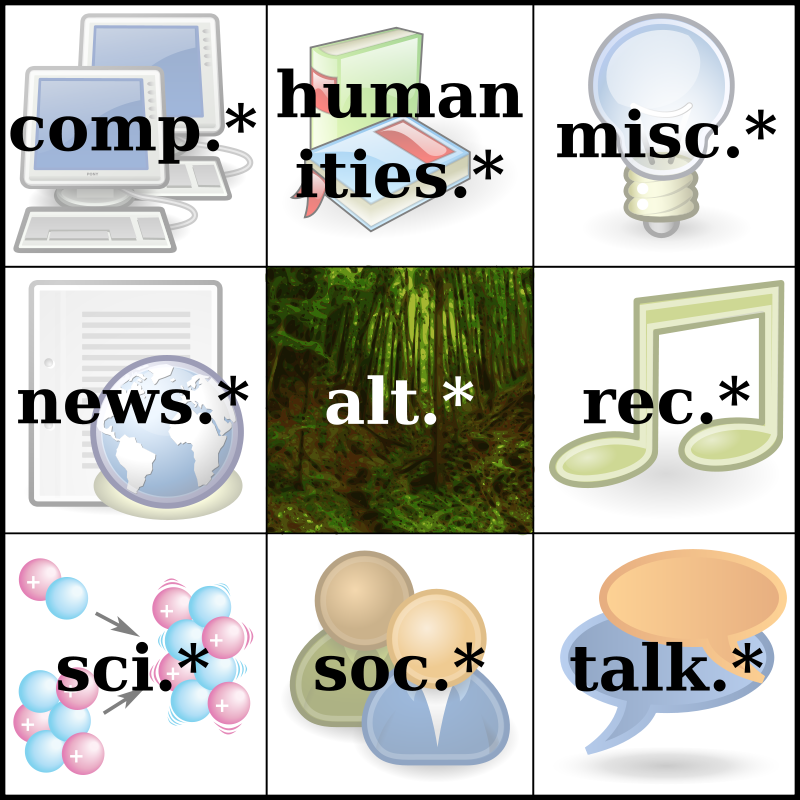Usenet

Usenet is a computer network used for communication and publishing files . Usenet consists of news groups in which users can post messages. Usenet had a great influence on the development of modern web culture, giving rise to such well-known concepts as “nickname”, “smile”, “signature”, “moderator”, “trolling”, “flood”, “flame”, “ban”, "FAQ" and "spam".
Since the 1990s, Usenet has been part of the Internet , rather than a separate network from it. Access to Usenet is carried out using the NNTP protocol - the application layer protocol of the OSI model .
Introduction
Usenet is one of the oldest networks and is still widely used today. Appeared in 1980 - long before the general public had access to the Internet in general and before the invention of WWW in particular. The system was developed at Duke University and was nicknamed the “ poor man's ARPANET.” In September 1993, the Internet provider AOL opened access to the Usenet network to its users. This event became the starting point for a new period in the life of the network, which the old-timers called “ Eternal September ”.
Currently, almost all Usenet traffic is transmitted over the Internet, and the format of messages and the method of their transmission is very similar to email . However, while email is used for one-to-one communication, Usenet operates on a one-to-one basis. Messages that a user posts on Usenet are organized into thematic categories called "newsgroups" or conferences, which are organized into a hierarchy similar to the structure of domain names . For example, groups are located within a hierarchy (short for science ). Using applications for working with Usenet, you can subscribe to any available conferences.
The user sends a message to one news server , which transmits the message to subscribing servers; they, in turn, transmit messages to their subscribing servers, and so on. Over time, the message spreads to all subscribed servers on the network.
Newsgroup servers
Many Internet providers provide free access to news servers. However, not every one of them is able to offer access to all news groups and their content. The volume of messages published on Usenet is large, and their storage and distribution involves high costs. That is why access to most of the data is provided for a fee by specialized news servers. The bulk of traffic comes from the hierarchy of binary newsgroups alt.binaries.*. In fact, users publish files and text messages like a general ftp server divided into topics . There is no file “sharing” as such, that is, in order to download something, you don’t need to share it with anyone, gain ratings, etc. - in this sense, Usenet is figuratively similar to a regular FTP server.
Conference structure
The main Usenet conference hierarchies are the:
comp.*: discussion of topics related to computers (comp.software,comp.sys.amiga);misc.*: various topics (misc.education,misc.forsale,misc.kids);news.*: Usenet news (news.groups,news.admin);rec.*: entertainment and recreation (rec.music,rec.arts.movies);sci.*: scientific discussions (sci.psychology,sci.research);soc.*: social topics (soc.college.org,soc.culture.african);talk.*: conversations, including on “hot” topics (talk.religion,talk.politics);humanities.*: art, literature, philosophy (humanities.classics,humanities.design.misc).
The hierarchy alt.*is not subject to the procedures that control the G8 newsgroups and, as a result, is less organized. But the groups can be more specialized: for example, the G8 may have a group dedicated to children's literature, and the G8 may have alt.* a group about a specific author. Binary files are published in alt.binaries.*, which makes the hierarchy altthe largest in terms of data volume.
There are hierarchies designed for a specific region ( japan.*), or discussions about the products of a specific company ( microsoft.*).
The hierarchy fido7.ru.*includes echo conferences of the Fidonet network in Russian .
Uploading and publishing files on Usenet
Usenet servers duplicate (partially or completely) the information stored by each other so that their users can communicate with each other. However, they do not work synchronously. Each of them has its own restrictions on the amount of information downloaded from other servers and the retention rate . Moreover, the server administration itself determines which groups to synchronize and to what extent. Paid servers secretly welcome almost any content, including copyright infringement .
Among the factors that complicate publishing on Usenet, there is a limitation on the size of one publication (number of lines / megabytes). On each server farm, the administration sets its own limit. Therefore, before publishing large files, for example, movies or disk images, you need to split them into parts no larger than 50 megabytes. This is a necessary recommendation and a rule of good manners. Small files are better distributed between servers and their integrity is preserved.
In case of possible loss or damage to individual volumes of archives or files, PAR2 files ( parchive , parity file ) are used, containing the necessary data for monitoring and error correction. With their help, files can be easily restored and supplemented in case of partial loss. Typically, the QuickPar utility is used to work with PAR2 .
All files available on Usenet, be it music, images, videos, software, disk images, games and others, are presented in text encoding and attached to the message, just like in email.
The yEnc encoding is very popular as it is the most compact.
- Arts
- Business
- Computers
- Jogos
- Health
- Início
- Kids and Teens
- Money
- News
- Recreation
- Reference
- Regional
- Science
- Shopping
- Society
- Sports
- Бизнес
- Деньги
- Дом
- Досуг
- Здоровье
- Игры
- Искусство
- Источники информации
- Компьютеры
- Наука
- Новости и СМИ
- Общество
- Покупки
- Спорт
- Страны и регионы
- World


